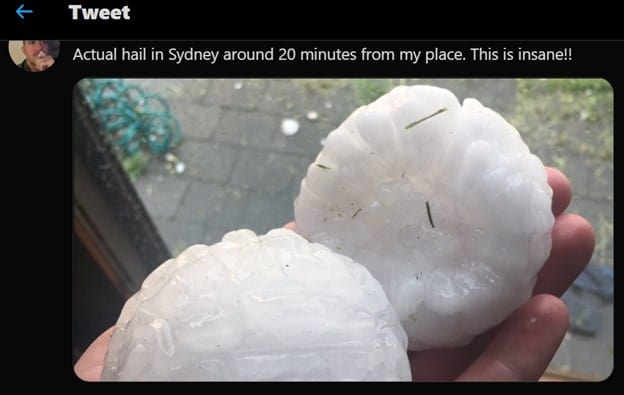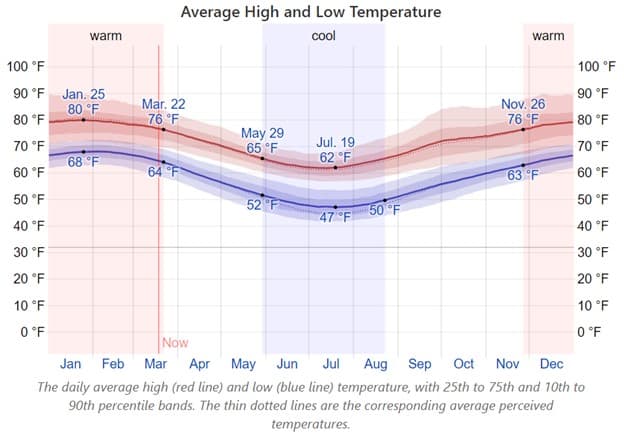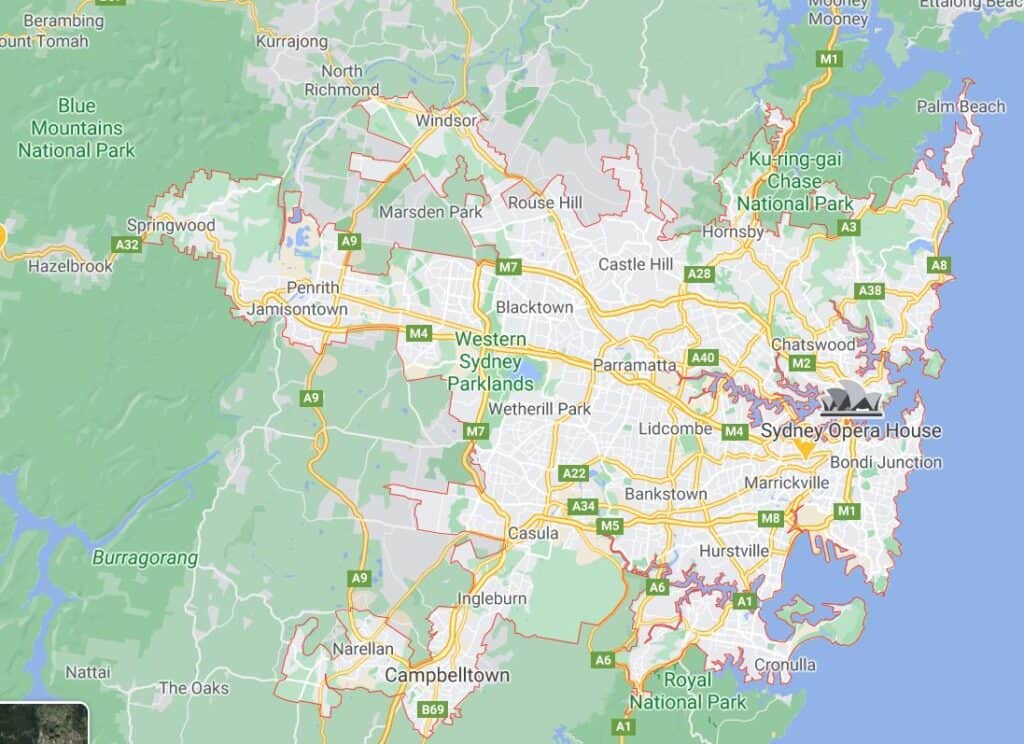I was born near Sydney Australia and, although I’ve lived in Canada for most of my life, I’ve spent lots of time in Sydney. You’ve probably read generalized reports about winter in Sydney, but after reading several posts, I can tell you that few are based on personal experience.
The chances of snow in Sydney are extremely slim, but not totally impossible. Sydney experiences hail most years and soft hail or graupel that doesn’t melt right away can also look like snow. The coldest month is July, with cool nighttime temperatures expected during June, July, and most of August. Frost can be expected in the Western suburbs of Sydney during the winter months.
Cold is relative of course. Someone living in Fiji has a different experience of cold than someone living in Tuktoyaktuk, although both might claim to be cold at times. (My money is on someone living in Tuktoyaktuk!)
The thing that most travel websites don’t tell you is that 39 F or 4 C feels &#* cold inside a house or apartment without heat or insulation. 4 degrees C can be downright balmy in Canada on a sunny day without breeze. Indoors in Australia, 39 F or 4 degrees C feels like you’re living in a refrigerator.
Snowfall in Sydney is Extremely Rare – But Hail Isn’t!
The last recorded snowfall was in June 1836, and some meteorologists think it may have been soft hail.
Perhaps we’re being a bit too picky about snow vs hail. Yes, snow is extremely rare in Sydney, but hail isn’t.
Soft hail, or graupel, can blanket the ground and it looks like snow unless you’re a meteorologist. This is exactly what happened in July 2008, when graupel fell in some Sydney suburbs and didn’t melt right away. Locals thought it was snow because – well, it was white, and cold, and icy. Maybe it even tasted like snow. That’s a dumb beginner mistake as any meteorologist can tell you. You can’t distinguish snow by taste alone.
Of course, graupel probably shovels like snow, so that’s all that really counts.
Keep in mind that most of the big hailstorms that hit Sydney and eastern Australia occur during the hottest months from December to March.
Can Hailstorms Cause Damage in Sydney?
You bet!
The costliest hailstorm in Australian history hit Sydney in April 1999. The cost of this one storm alone was A$1.5 billion in 1999 dollars – or about A$4 billion in today’s money. The 1999 Sydney hailstorm damaged 20,000 properties and 40,000 vehicles with more than 25 aircraft damaged at Sydney Airport. One person was killed by lightning and several others were injured. The largest hailstone measured was almost the size of a grapefruit at 3.7 inches (9.5 cm).
Another expensive hailstorm hit Sydney in December 2018, causing severe loss across suburban Sydney, and destroying or damaging almost 95,000 vehicles. There were 136,424 insurance claims after the hailstorm, costing AUD $1.271 billion (USD $910 million) according to the Insurance Council of Australia.
Here’s what an internet search will reveal for the 2018 Sydney hailstorm, showing some of the damage to vehicles.

Here’s an image posted to Twitter showing what really big hailstones look like.

Winter in Sydney Australia
So, what can you expect during the coldest months in Sydney?
The chances of experiencing snow or even hail in the winter are extremely low.
One of the best sources available for a quick look at the climate in almost any location is weatherspark.com.

The beauty of this graphic summary is that you can quickly get an overview of the best times to visit based on the historic weather data. Weatherspark even uses a proprietary ‘tourism score’ to delineate the most comfortable months to visit. According to this system, the best time to visit Sydney is December to early-April.
(A word of advice about visiting Australia in their summer – the holiday period in December and all of January are school holidays and Aussies are mad about travel, so accommodation becomes difficult to find and the most popular roads and motorways are plugged solid.)
Here’s a detailed view of the monthly temperature range in Sydney, once again courtesy of weatherspark.com.

Microclimate Makes a Big Difference in Temperatures
Greater Sydney covers a large area, with big differences in temperature between central Sydney and the western suburbs. Winter in the CBD (central business district) is relatively mild with lows rarely dropping below 45 °F or 7 °C.
In the western suburbs, winter temperatures can range from highs of 66 °F or 19 °C during the day and as low as 37 °F (3 °C) at night. Low temperatures in that range can bring mild to moderate frost in these areas. In the suburb of Richmond you can experience lows going below 32 °F or 0 C.
Once you get up to Springwood you are in the Blue Mountains, and that gets much cooler in the winter.

What is the Aussie Winter Like Indoors?
As I’ve mentioned the thing to keep in mind, is that these temperatures can feel surprisingly cold when you first get up in the morning, since most units – especially the older ones – have little or no insulation and no central heat. If you are staying at an AirBnB or commercial accommodation you may be lucky enough to find electric heaters that you can plug in.
In Australia, the further south you go, the colder it gets in the winter. You would think that indoor heat was a priority, but here’s a tip – take some extra sweaters!
Australian researchers write that “Australia may well be a sunburnt country, but even though most of us live in parts of the nation with a mild climate, an increasing pool of empirical and anecdotal evidence suggests our houses are some of the coldest in the world.”
I can personally confirm that with my own empirical evidence!
One last thought…
What about graupel you ask!? Yes, well graupel – or soft hail – does have a snow-like appearance and can easily be mistaken for snow. But the odds of seeing it are very slim during the winter months. You would have a much higher probability of experiencing hail in the Australian summer.
Now, doesn’t that complicate the question of whether it snows in Sydney?
I hope you’ve enjoyed reading about the complexities of winter and summer weather in Sydney, Australia.
I urge you to check out my related article on ‘How to Find Travel Destinations with the Best Weather’ – using a system that works anywhere in the world.
See Our TOP Articles for More Fascinating Creatures
- How do Octopus Reproduce? (Cannibalistic Sex, Detachable Penis)
- How Smart are Octopuses? Are Octopuses As Intelligent as Dogs?
- Do Jellyfish have Brains? How Can they Hunt without Brains?
- Why are Deep Sea Fish So Weird and Ugly? Warning: Scary Pictures!
- Are Komodo Dragons Dangerous? Where Can you See Them?
- Koala Brains – Why Being Dumb Can Be Smart (Natural Selection)
- Why do Lions Have Manes? (Do Dark Manes Mean More Sex?)
- How Do Lions Communicate? (Why Do Lions Roar?)
- How Dangerous are Stonefish? Can You Die if You Step on One?
- What Do Animals Do When They Hibernate? How do they Survive?
- Leaf Cutter Ants – Surprising Facts and Adaptations; Pictures and Videos
- Irukandji Jellyfish Facts and Adaptations; Can They Kill You? Are they spreading?
- How to See MORE Wildlife in the Amazon: 10 Practical Tips
- Is it Safe to go on Safari with Africa’s Top Predators and Most Dangerous Animals?
- What to Do if You Encounter a Bullet Ant? World’s Most Painful Stinging Insect!
- How Do Anglerfish Mate? Endless Sex or Die Trying!
- How Smart are Crocodiles? Can They Cooperate, Communicate…Use Tools?
- How Can We Save Our Oceans? With Marine Sanctuaries!
- Why Are Male Birds More Colorful? Ins and Outs of Sexual Selection Made Easy!
- Why is the Cassowary the Most Dangerous Bird in the World? 10 Facts
- How Do African Elephants Create Their Own Habitat?
- What is Killing Our Resident Orcas? Endangered Killer Whales
- Why are Animals of the Galapagos Islands Unique?
- Where Can You See Wild Lemurs in Madagascar? One of the Best Places
- Where Can You see Lyrebirds in the Wild? the Blue Mountains, Australia
- Keeping Mason Bees as Pets
- Why do Flamingos have Bent Beaks and Feed Upside Down?
- Why are Hippos Dangerous? (Do They Attack People?)

